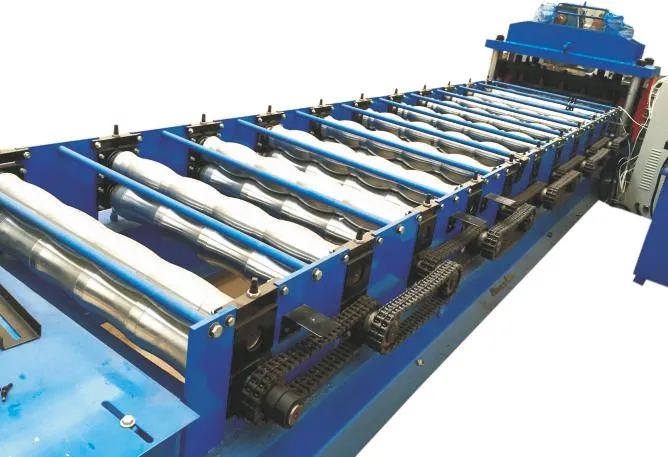How Forming Machine Work and Its Types

Forming machines are essential to numerous sectors, including electronics, medical, and aerospace as well as automotive and aerospace. These strong machines create the parts and goods we depend on every day by transforming raw materials into an enormous variety of forms and sizes.
Types of Forming Machines
1. Gear Box Driven Forming Machine
The workhorses of the metalworking industry, gear-driven forming machines shape and mould metal sheets and other materials into a wide range of components and products. They provide a strong and accurate high-volume manufacturing solution that can handle a variety of materials and thicknesses.
How Gear Box Driven Forming Machines Work
A gearbox is the central component of a gear-driven forming machine, transferring power from an electric motor to the forming tools. Accurate and consistent outcomes are ensured by the gearbox's ability to precisely manage the forming process's torque and speed. To produce the required forms and profiles, there are several configuration options for the forming tools themselves.
Types of Gear Box Driven Forming Machines
- Presses: Presses are the most common type of gear-driven forming machine. They use a ram and die to apply pressure to the material, forming it into the desired shape.
- Roll forming machines: Roll forming machines use a series of rollers to continuously form the material into the desired shape. They are ideal for creating long, straight parts.
- Bending machines: Bending machines use a punch and die to bend the material along a desired axis.
- Shearing machines: Shearing machines use a blade to cut the material to the desired size and shape. They are often used in conjunction with other forming machines.
2. Chain Driven Forming Machine
Chain-driven forming machines transfer power from an electric motor to the forming tools via a chain rather than a gearbox. Compared to a gearbox, a chain offers a greater range of speeds and power, making it more adaptable to various forming applications.
Applications of Chain Driven Forming Machines
Chain-driven forming machines are an excellent choice for a variety of applications, including:
- Low-volume production: Chain-driven forming machines are ideal for low-volume production runs, as they are less expensive to purchase and operate than gear-driven forming machines.
- Prototype development: Chain-driven forming machines are often used for prototype development, as they allow for quick and easy changes to the forming tools.
- Short-run production: Chain-driven forming machines can be used for short-run production runs, as they can be set up and running quickly.
- Repair and maintenance: Chain-driven forming machines are often used for repair and maintenance tasks, as they are portable and easy to use.
Types of Chain Driven Forming Machines
Chain-driven forming machines are used for many of the same applications as gear-driven forming machines, including:
- Presses: Chain-driven presses are used to form a variety of parts, such as automotive components, appliance parts, and construction materials.
- Roll forming machines: Chain-driven roll forming machines are used to create long, straight parts, such as pipes, channels, and beams.
- Bending machines: Chain-driven bending machines are used to bend sheet metal and other materials along a desired axis.
- Shearing machines: Chain-driven shearing machines are used to cut sheet metal and other materials to the desired size and shape.
Chain Driven Forming Machine
Many different industries use forming machines, including:
- Automotive: Body panels, chassis pieces, and engine parts are just a few of the items that are made by forming machines for vehicles and trucks.
- Aerospace: Parts for aeroplanes, spacecraft, and missiles are made using forming machines.
- Medical: Syringes, catheters, implants, and other medical equipment are made with forming machines.
- Electronics: Circuit boards and connections, among other electronic components, are made using forming machines.
- Construction: A wide range of construction materials, including beams, pipes, and panels, are produced using forming machines.
The Future of Forming Machines
Forming machines are always changing in step with technological advancements. Further advancements in automation, control systems, and materials science allow the creation of forming machines that are even more effective and adaptable. More complex forms and sizes will be able to be produced by these machines with increased efficiency and accuracy.
People also read :
https://weldarcindia.com/blog/CNC-Plasma-Cutting-Machine-
https://weldarcindia.com/blog/Top-10-Fiber-Laser-Cutting-Machine-Manufacturers
https://weldarcindia.com/blog/CNC-Fiber-Laser-Cutting-Machine
https://weldarcindia.com/blog/Know-About-MIG-Welding-Machines
https://weldarcindia.com/blog/Welding-Automation-in-the-Automotive-Industry
https://weldarcindia.com/blog/What-is-a-Fiber-Laser-Cutting-Machine
https://weldarcindia.com/blog/CNC-Plasma-Cutting-Machine-
https://weldarcindia.com/forming-machines.php
https://weldarcindia.com/spares-and-accessories.php

